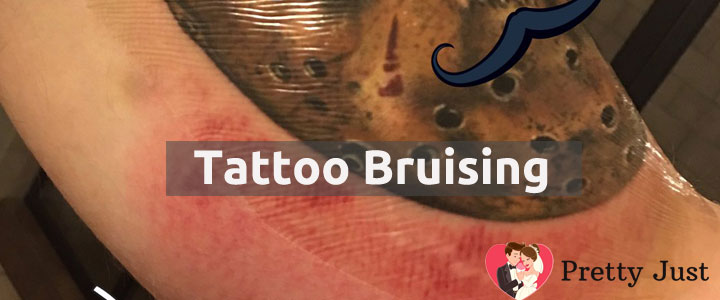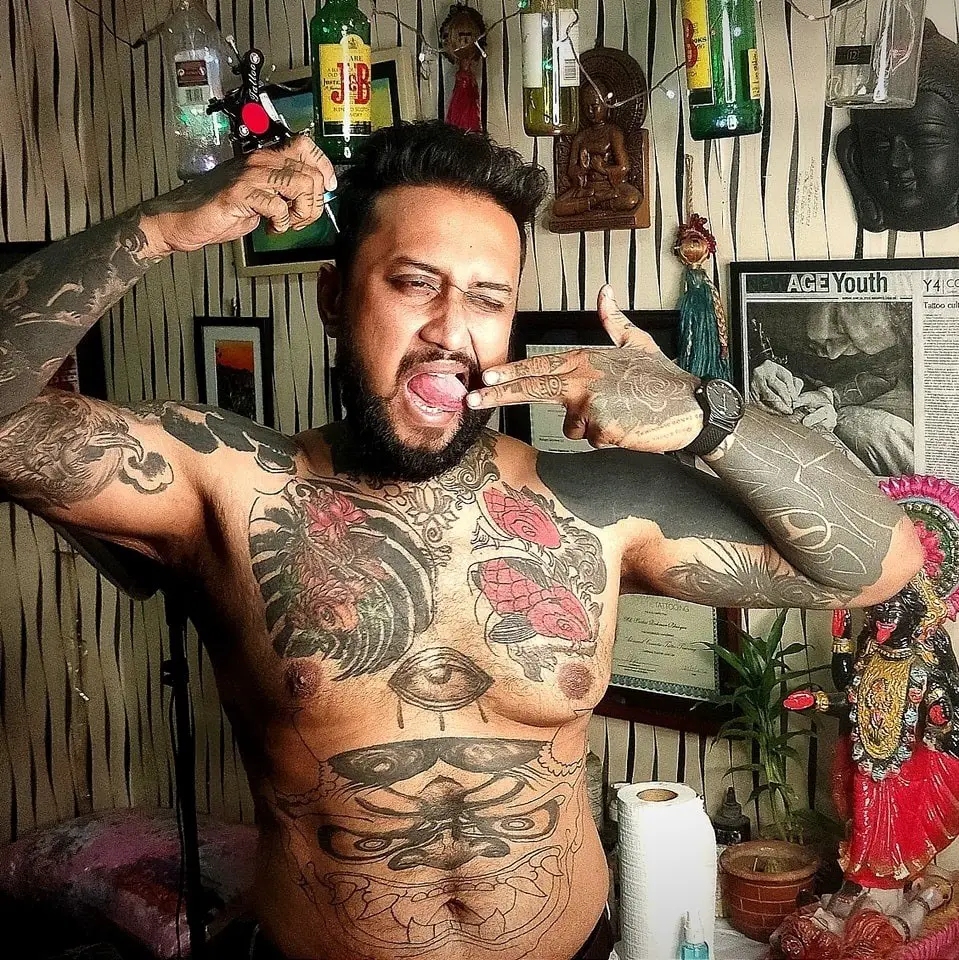Tattoo bruising can occur as a result of the tattooing process, where repeated needle punctures cause minor trauma to the skin and underlying tissues. Symptoms include visible discoloration and tenderness around the tattooed area. Managing tattoo bruising involves applying cold compresses, elevating the affected area, and allowing sufficient rest and recovery time. Avoiding blood thinners and monitoring for signs of infection are crucial.
Seek medical attention if bruising is severe, spreads rapidly, or if symptoms persist or worsen.
However, the thing with tattoo bruising is that it’s usually harmless. It’s not necessarily a part of the standard experience but it’s definitely not that uncommon. If you want to know more about tattoo bruising, allow us to elaborate below.
| Aspect | Description |
|---|---|
| Causes | – Trauma to Skin: Tattooing involves repeated needle punctures, which can cause minor trauma to the skin and underlying tissues, leading to bruising. |
| – Sensitive Skin: Individuals with sensitive or thin skin may be more prone to bruising during tattooing. | |
| – Ink Depth and Technique: Tattooing too deeply or using aggressive techniques can increase the likelihood of bruising. | |
| Symptoms | – Discoloration: Bruising appears as a blue or purple area around the tattooed skin, indicating blood pooling beneath the surface. |
| – Tenderness: The bruised area may feel tender or sore to the touch, especially immediately after the tattoo session. | |
| Management | – Cold Compress: Applying a cold compress or ice pack wrapped in a cloth to the bruised area can help reduce swelling and discomfort. |
| – Elevation: Keeping the tattooed area elevated above the heart level can assist in reducing swelling and promoting circulation. | |
| – Rest and Recovery: Allow adequate time for rest and avoid activities that may aggravate the bruised area until it heals. | |
| – Avoid Blood Thinners: Refrain from consuming alcohol and medications like aspirin or ibuprofen that can thin the blood and exacerbate bruising. | |
| When to Seek Help | – Excessive Bruising: If bruising is severe, spreads rapidly, or is accompanied by signs of infection (e.g., warmth, pus), seek medical attention promptly. |
| – Persistent Symptoms: If bruising persists beyond a few days or worsens instead of improving, consult with a healthcare provider. |

3 Things You Need to Know About Tattoo Bruising
Tattoo Bruising Is Normal
As mentioned above, tattoo bruising may seem scary but it’s typically harmless. Why? It’s just really how your body responds to the skin trauma that the process of tattooing inflicted on you.
Bruises are usually caused by a cut or a blow which can cause small blood vessels or capillaries to break, causing blood to leak and get trapped under the skin’s surface. This causes discoloration in the area which is usually blue, black, very dark red, or yellow.
Since the act of tattooing involves punching through the skin so the ink can be delivered into the dermis, it can certainly cause some skin trauma.
In addition to this, the tattoo machine in itself can also be the very culprit behind your bruising. Since they tend to hit the skin repeatedly while the needle breaks the surface, it’s creating a blow that can be damaging to very small blood vessels.
So, yes, there are good explanations for why your tattoo comes with some bruising. They’re not necessarily serious, so there’s no need to freak out about them. The bruise will feel a bit tender for a few days until it fades out and turn yellow. At that point, you’re well on your way to complete healing.
There Are Several Things That Can Cause Tattoo Bruising
Note, however, that not everyone bruises after getting a tattoo. Some are just more likely to get them than others because of various factors. A few of them are the following:
The Tattoo Location
Some parts of your body are more prone to bruising than the others. This usually has a lot to do with the amount of flesh near the surface of the skin and with how much strain the area gets. It’s very much the same as swelling as the same areas that are prone to swelling are also prone to bruising.
Where are these areas? Here are a few:
- Your lower extremities as blood flow upwards can become slow.
- Ankles, wrists, and other joints since they move a lot which puts more pressure on the damaged area.
- Body parts where the skin is thin like the periocular area. The skin around your eyes is very stretched out, thin, and delicate so they get damaged easily.
The Tattooist’s Handling
On many occasions, bruising is caused by how tattooists handle their machines and the tattoo machines themselves. Heavy-handed artists can really do some damage to their clients’ skin and that’s a pity. This is why you should also look into such details when looking for the right tattooist to work with.
How a tattoo machine hits can also be the reason for your bruising. Some of these devices can be too powerful that in the hands of an inexperienced artist will be quite hard to control. This will put your skin in jeopardy.
Skin Sensitivity
Some people just tend to bruise more easily than others. Older adults tend, those who are taking certain medications, and those with certain conditions tend to bruise more easily than others. So if you belong in any of these categories, expect to experience some bruising after the session.
Treating Bruised Tattoos Is Easy
The great thing about bruises is that they are easy to manage. If you want them to go away quickly, here are some effective steps to take:
- Elevate or apply an ice pack or a cold compress to restrict blood flow to the area.
- Rest the affected area to allow the healing process to take place fully.
- Apply healing creams like comfrey and arnica to speed up bruise healing time.
Tattoo Bruising vs. Tattoo Blowout
In some cases, what people believe to be a bruise isn’t actually one. Tattoo blowouts tend to look like bruises. This happens when the tattoo artist made the mistake of depositing ink in a deeper layer of the skin. As a result, the ink will spread out on the lower layer of the skin, making it look like you have a bruise.
Unfortunately, this mistake is hard to correct but can be quite common. They also can’t be fixed since the ink is already deposited on a deep skin layer. However, some tattooists are capable of covering them up, so that’s an option worth exploring. It might just affect the original design of your tattoo.
What you can do to avoid them is by choosing your tattoo artist very carefully. Skilled and experienced tattooists already know how to avoid making such mistakes.
FAQs on Tattoo Bruising
Know more about tattoo bruising with the help of our answers to some of the most commonly asked questions about the condition. Check them out below.
How Long Does A Tattoo Bruise Last?
Tattoo bruises should gradually disappear within the first week of the healing process of your new ink. However, as we don’t heal at the same rate, some folks might take longer to heal as well. It definitely shouldn’t last a month, however.
Does Ice Help Tattoo Bruising?
Yes, icing the bruised area can help speed up the healing process because it will restrict the blood flow to the area. Just be careful not to keep your new ink wet, however, to avoid other complications.
Should I Worry About The Bruising Around My Tattoo?
Not necessarily. As mentioned above, bruising is normal and should go away as your tattoo heals. However, if the bruising did not fade for quite a while, it might be best to seek medical help or see your tattoo artist, just in case it’s a tattoo blowout and not an actual bruise.
Conclusion
Tattoos can be quite injurious to the skin, so tattoo bruising should be expected. It might seem scary but it shouldn’t be a serious issue in most cases. Tattoo blowouts should worry you more instead, as they can ruin the overall look of your tattoo. But with the right tattoo artist, the chances of both can be minimized, so make sure to only trust a good one.


